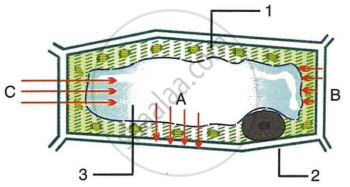Advertisements
Advertisements
प्रश्न
Give reason for the following:
It is better to transplant seedlings in a flower-bed in the evening and not in the morning.
उत्तर
Transplantation causes stress on the seedlings. If the seedlings are transplanted in the morning, they would have to immediately bear the additional stress of excessive transpiration occurring during the hot afternoon. Transplantation in the evening helps the seedlings adjust for a longer time during the night (cooler temperatures) because the quantity of water absorbed exceeds the loss of water through transpiration. Therefore, it is better to transplant seedlings in a flower bed in the evening and not in the morning.
APPEARS IN
संबंधित प्रश्न
Give the equivalent term for the following:
The condition in which the cell contents are shrunken.
What is the difference between ‘flaccid’ and ‘turgid’? Give one example of flaccid condition in plants.
Distinguish between the following:
Flaccid condition and turgid condition
Give Technical Term for the following.
A cell in a fully extended condition.
Give Technical Term for the following.
The pressure exerted by cell contents on a plant cell wall.
Mention, if the following statement is True or False. If false rewrite the wrong statement in its correct form:
Flaccidity is the reverse of turgidity.
Fill in the Blank
Wilting and drooping of leaves is due to loss of ________.
When the cells of a plant are fully distended, the condition is called ______.
Addition of salt to pickles is a method of killing the bacteria by ______.
Given below is the figure of a plant cell showing different kinds of pressure acting upon it. Study the figure and answer the questions that follow:

- In the figure, 1, 2 and 3 represent:
- Cytoplasm, Nucleus, Vacuole respectively
- Vacuole, Cytoplasm, Cell wall respectively.
- Cytoplasm, Cell membrane and vacuole respectively.
- Cytoplasm, Cell wall and Vacuole respectively.
- B in the figure represents:
- Osmotic pressure
- Turgor pressure
- Wall pressure
- Diffusion pressure
- A in the figure represents:
- irnbibition pressure
- Wall pressure
- Turgor pressure
- Osmotic pressure
- C in the figure represents:
- Turgor pressure
- Osmotic pressure
- Wall pressure
- Imbibition pressure
- Draw a neat and labelled diagram of a plasmolyzed plant cell.
